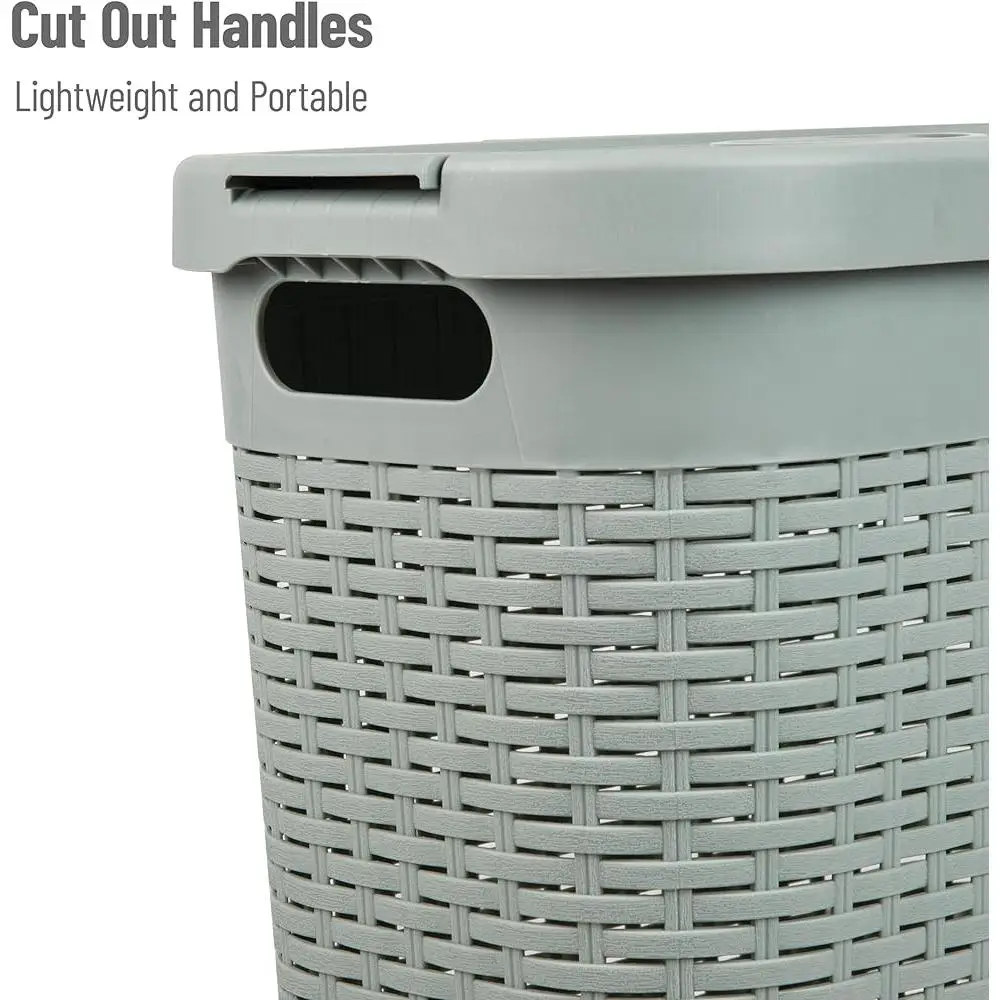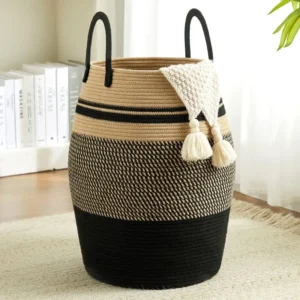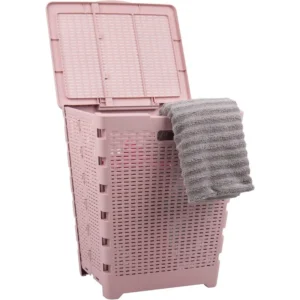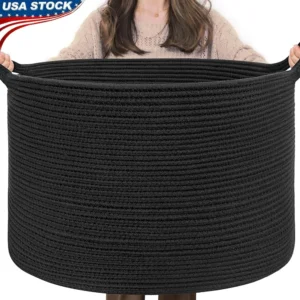In many homes, the sight of a full laundry basket often triggers a resigned sigh – another chore to add to the never-ending to-do list. Yet this humble household item serves as much more than just a simple reminder of pending tasks. A full laundry basket represents an intricate system of home organization, a trigger for psychological well-being, and even carries symbolic meaning in our daily lives.
The average household spends between 7-9 hours weekly on laundry-related tasks, making it one of our most consistent home routines. This time investment isn’t merely about clean clothes – it’s about creating order from chaos, establishing healthy habits, and maintaining both physical and mental wellness.
Far from being just a container, a quality laundry basket serves as the cornerstone of effective home management. When we understand the full spectrum of benefits that come from proper laundry organization – from reducing physical clutter to alleviating mental stress – we begin to appreciate this everyday item in an entirely new light. As we’ll discover, conquering clutter through space-saving laundry solutions offers benefits that extend far beyond just having clean clothes.
Let’s unpack the many layers of advantages that come with a full laundry basket and explore how this simple household staple contributes to a more organized, healthier, and psychologically balanced home environment. The benefits of laundry baskets extend far beyond their obvious function.
The Organizational Symphony: Practical Benefits of a Full Laundry Basket
At its core, a laundry basket is a simple organizational tool, yet its impact on home management is profound. When properly integrated into daily routines, it creates a system that keeps living spaces tidy and laundry processes streamlined.
Studies show that organized homes spend approximately 40% less time on cleaning tasks overall. This remarkable efficiency begins with simple tools like a well-placed laundry basket that prevents the scatter of dirty clothes throughout living spaces.
A full laundry basket serves multiple practical purposes:
- Creates a centralized collection point for dirty clothes
- Prevents clothing clutter from accumulating in bedrooms and bathrooms
- Provides visual feedback on when laundry needs attention
- Protects garments from damage before washing
- Simplifies the transportation of laundry to washing machines
- Enables efficient pre-sorting of different fabric types or colors
Investing in quality laundry solutions transforms what might otherwise be a chaotic process into an orderly system that saves both time and frustration.
Clutter Commander: Centralized Collection System
A strategically placed laundry basket acts as a command center for managing household textile chaos. Rather than allowing dirty clothes to accumulate on chairs, floors, or bathroom counters, a designated basket provides a specific destination for these items.
For optimal effectiveness, laundry baskets should be placed in high-traffic areas where clothes are most frequently removed – primarily bedrooms and bathrooms. Some households benefit from multiple collection points, with smaller baskets in each bedroom and bathroom feeding into a larger main basket in the laundry area.
This centralized collection approach prevents the gradual spread of clothing items throughout the home, which can contribute significantly to the appearance of household disorder. Space-saving laundry basket solutions are particularly valuable for smaller homes where maintaining order requires thoughtful planning.
Efficient Transport: From Collection to Washing Machine
The design of a quality laundry basket is specifically engineered for ergonomic transport of bulky textile items. While our arms might manage to carry 5-7 garments at once, a standard laundry basket comfortably accommodates 15-20 items, dramatically reducing the number of trips between collection and washing areas.
This efficiency becomes particularly valuable in homes where laundry facilities are located on different floors or in separate areas from bedrooms and bathrooms. With appropriate handles and balanced weight distribution, baskets with sturdy construction allow for comfortable transportation even when fully loaded.
Many homeowners find that wicker baskets with handles offer the perfect combination of durability, comfort, and aesthetic appeal for this purpose. These baskets provide structural integrity while being gentle on fabrics and comfortable to carry.
The Visual Prompt: Encouraging Regular Laundry Routines
Perhaps one of the most underappreciated benefits of a laundry basket is its function as a visual prompt or reminder system. Research on habit formation consistently shows that visual cues are powerful triggers for routine behaviors.
A basket that’s three-quarters full serves as a clear indicator that laundry day should be scheduled soon. This visual feedback helps establish consistent washing routines that prevent overwhelming accumulation of dirty clothes – a common source of household stress.
Unlike digital reminders or calendar notifications, the filling laundry basket provides a natural, unobtrusive prompt that integrates seamlessly into daily life. For many households, this visual cue becomes an essential part of maintaining regular cleaning schedules without the need for additional planning or reminder systems.
Beyond Clean Clothes: Psychological Benefits of Regular Laundry Cycles
The impact of a well-managed laundry system extends far beyond physical organization into the realm of psychological well-being. Research consistently demonstrates connections between orderly environments and mental health, with organized spaces contributing to reduced stress levels and improved cognitive function.
When we address a full laundry basket, we’re not just cleaning clothes – we’re engaging in an activity that has measurable psychological benefits:
- Reduces visual clutter that contributes to mental distraction
- Provides a sense of accomplishment and control
- Creates opportunities for mindfulness through repetitive tasks
- Establishes predictable routines that enhance feelings of security
- Delivers the mood-boosting effects of fresh, clean textiles
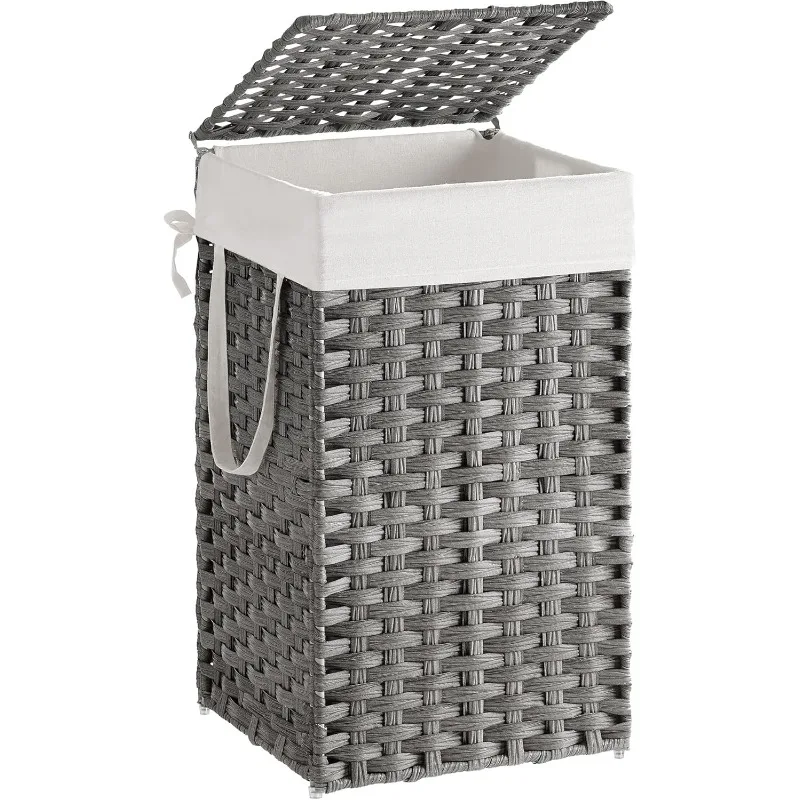
For many people, stylish wicker laundry baskets with lids offer the added psychological benefit of concealing visual clutter while maintaining easy access – providing calm to the home environment even between laundry sessions.
The Calm in Order: Reducing Mental Clutter
The relationship between physical clutter and mental distress has been well-documented in psychological research. A 2010 study published in the Journal of Personality and Social Psychology found that women who described their homes as cluttered or unfinished had higher levels of cortisol (the stress hormone) than those who described their homes as restful and restorative.
The laundry process offers a unique opportunity to reduce both physical and mental clutter simultaneously. The repetitive, predictable nature of sorting, washing, folding, and putting away creates a rhythm that many find calming and meditative. This rhythmic activity allows the mind to enter a flow state where anxious thoughts naturally subside.
When dirty laundry accumulates beyond the capacity of its designated container, it creates visual disorder that can trigger stress responses. Mastering compact laundry storage systems helps maintain the boundary between order and chaos, contributing significantly to a sense of calm in the home environment.
Achievement Unlocked: Satisfaction in Completion
There’s a special satisfaction that comes from emptying a full laundry basket, completing the washing cycle, and returning fresh, clean garments to their proper places. This satisfaction stems from what psychologists call the “completion principle” – our intrinsic desire to finish what we start.
Each completed laundry cycle triggers a small dopamine release in the brain – the neurotransmitter associated with reward and motivation. This chemical response reinforces the behavior and creates positive associations with the task.
The visible progress from full basket to empty basket to neatly folded piles provides concrete evidence of accomplishment – something particularly valuable in today’s world where many forms of work produce less tangible results. This visual confirmation of progress contributes to feelings of capability and environmental mastery, important components of psychological well-being.
Fresh Start Effect: Clean Clothes and Renewed Mindset
Clean, fresh-smelling clothes and linens contribute to overall mood and confidence in ways that extend far beyond physical comfort. The sensory experience of freshly laundered textiles – their scent, texture, and appearance – creates what psychologists sometimes call a “fresh start effect,” a mental reset that can improve outlook and motivation.
Research in environmental psychology suggests that our physical surroundings, including the cleanliness of our clothing and bedding, significantly impact our self-perception and social confidence. People consistently report feeling more prepared, professional, and positive when wearing freshly laundered clothes.
The choice of laundry basket material can even influence this experience. Many consumers find that wicker baskets for laundry provide better ventilation than plastic alternatives, reducing musty odors that can develop in dirty laundry awaiting washing.
Health and Hygiene: The Unsung Benefits of Regular Laundering
Beyond organization and psychological benefits, a full laundry basket prompting regular washing cycles contributes significantly to household health and hygiene. The accumulation of unwashed textiles creates ideal environments for microorganisms that can impact physical wellbeing.
Regular laundering triggered by a filling basket:
- Eliminates bacteria that multiply on worn clothing
- Removes allergens like pollen, dust mites, and pet dander
- Washes away skin cells that accumulate in bedding
- Extracts environmental pollutants trapped in fabric fibers
- Reduces musty odors caused by moisture-loving microorganisms
- Removes perspiration residue that can irritate skin
Using woven laundry washing baskets with proper ventilation helps manage these concerns even before washing begins by allowing airflow that discourages bacterial growth in waiting laundry.
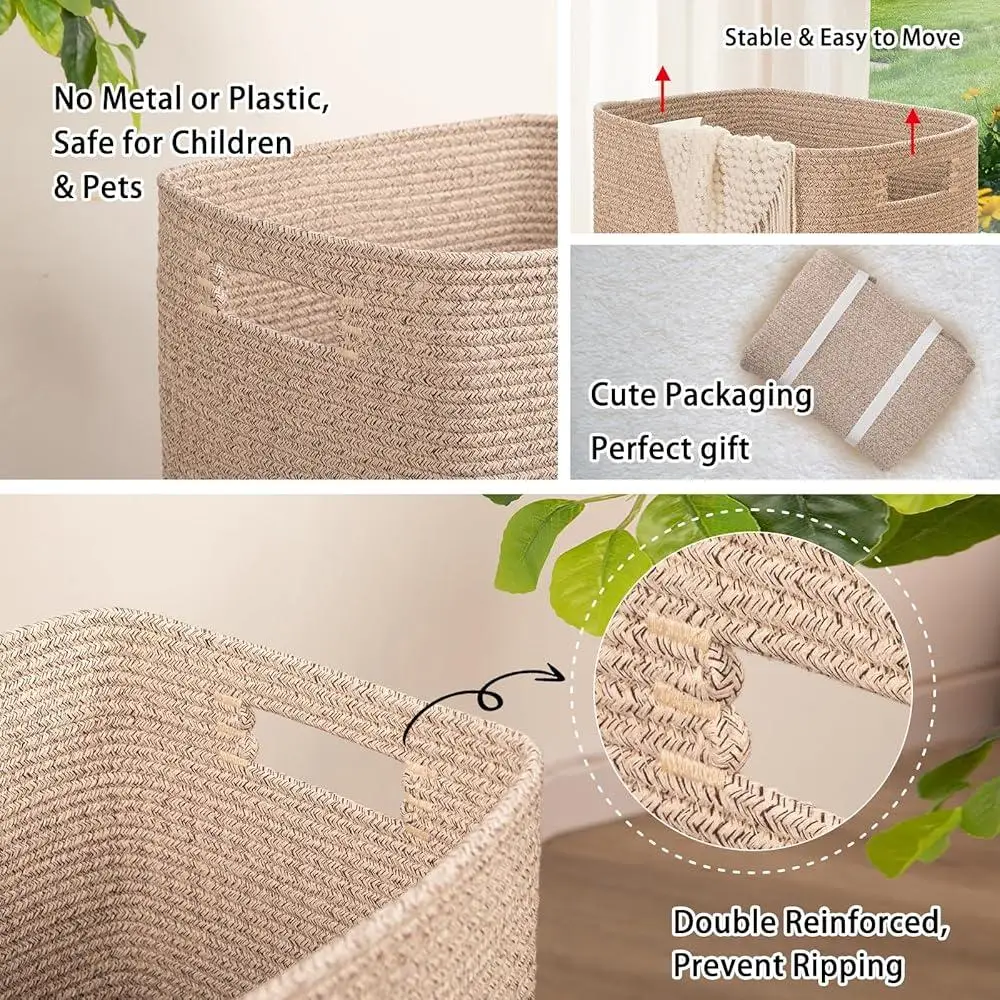
Germ Guardian: Eliminating Microscopic Threats
The fabrics we wear and sleep in harbor surprising amounts of microorganisms. Studies show that unwashed bath towels can contain millions of bacteria after just three uses, while bedsheets typically accumulate over 10 million bacteria per square inch after one week of use.
Regular laundering triggered by a full basket interrupts the life cycle of these microorganisms. Washing machines combine several antimicrobial mechanisms:
- Mechanical agitation physically removes microbes
- Detergents break down oils where bacteria thrive
- Hot water temperatures kill many common pathogens
- Rinse cycles flush away loosened contaminants
For optimal hygiene, towels should be washed after 3-4 uses, bedsheets weekly, and clothing items that directly contact skin after 1-2 wearings. A properly sized laundry basket helps establish these rhythms by filling at appropriate intervals based on household size.
The temperature and detergent choices matter significantly for hygiene purposes. While modern detergents work effectively at lower temperatures, studies suggest that water temperatures of at least 140°F (60°C) are most effective for eliminating many pathogens, particularly in bedding and towels.
Allergy Alleviation: Creating a Cleaner Home Environment
For the approximately 50 million Americans who suffer from allergies, regular laundering of textiles plays a crucial role in symptom management. Fabrics throughout the home collect and trap common allergens including:
- Dust mite waste products (a primary indoor allergen)
- Pollen particles that enter on clothing and hair
- Pet dander that accumulates in bedding and upholstery
- Mold spores that thrive in damp environments
When these textiles are regularly washed according to schedules prompted by filling laundry baskets, allergen loads in the home environment are significantly reduced. Medical professionals often recommend that allergy sufferers wash bedding weekly in hot water (130°F/54°C or higher) to kill dust mites and remove their allergenic waste products.
For those living in smaller homes where organization is particularly important, small space laundry basket solutions can help maintain these health-promoting routines without creating additional clutter or taking up valuable floor space.
The Psychological Symbolism of Laundry Management
Beyond the practical and health-related benefits, laundry and its management carry rich symbolic meaning across cultures and throughout literature and psychology. These deeper meanings often reflect how we view responsibility, transformation, and life management.
In literature and common expressions, laundry often serves as a powerful metaphor:
- “Airing dirty laundry” represents revealing private problems
- “Cleaning house” suggests both physical and emotional purging
- The transformation from soiled to clean represents renewal
- The repetitive cycle parallels life’s ongoing challenges
These metaphors aren’t coincidental – they reflect deep psychological connections between physical cleaning processes and emotional or mental states.
Metaphorical Weight: When Laundry Represents Life’s Burdens
An overflowing laundry basket often symbolizes feeling overwhelmed by responsibilities or emotional baggage. The visual of clothing piling beyond the container’s capacity parallels how life’s demands can exceed our perceived capacity to manage them.
Psychologists note that how we respond to accumulated laundry often mirrors our broader coping mechanisms. Some avoid the growing pile until it becomes unmanageable, while others maintain strict routines to prevent accumulation – patterns that typically extend to other life areas.
The concept of “airing dirty laundry” – discussing private problems publicly – stems from the historical practice of washing clothes in community settings where private stains became public knowledge. This metaphor highlights the vulnerability we feel when our “messes” are visible to others.
Understanding the differences between laundry baskets and hampers can help determine which solution better contains both the physical items and the psychological weight they sometimes represent.
Renewal Cycle: The Transformation from Soiled to Clean
The process of laundering – taking soiled items through washing and drying to emerge clean and renewed – provides a powerful physical metaphor for personal transformation and renewal. This symbolism appears across diverse cultural traditions.
In many spiritual practices, water is seen as a purifying element that cleanses both body and spirit. The laundry process, centered around water’s cleansing properties, echoes these purification rituals. The satisfaction we feel from completed laundry may connect to this deep symbolic association with renewal.
The cyclical nature of laundry – clean clothes become soiled, are washed, and become clean again – also parallels natural cycles and the ongoing nature of personal growth and renewal. This continuous process reminds us that maintenance and care are ongoing requirements rather than one-time achievements.
Practical Application: Optimizing Your Laundry System
With a deeper understanding of the many benefits a well-managed laundry system provides, we can approach basket selection and placement more thoughtfully. Creating an efficient laundry management system begins with choosing the right tools for your specific household needs.
When selecting laundry baskets, consider:
- Size appropriate for your household’s laundry volume
- Material that balances durability, aesthetics, and function
- Design features that support your specific laundry workflow
- Ventilation requirements for different climate conditions
- Visual compatibility with your home’s interior design

For homes where aesthetics matter alongside functionality, wicker laundry hampers offer an attractive solution that contributes to home decor while fulfilling practical needs.
Wicker Laundry Baskets, Woven Laundry Baskets, Woven Storage Baskets
$392.02 Select options This product has multiple variants. The options may be chosen on the product pageWicker Baskets with Handles, Wicker Storage Baskets, Woven Storage Baskets
$137.92 Select options This product has multiple variants. The options may be chosen on the product pageLarge Wicker Laundry Baskets, Tall Wicker Baskets, Woven Laundry Hampers, Woven Storage Baskets
$130.54 Select options This product has multiple variants. The options may be chosen on the product pageWoven Laundry Baskets, Woven Laundry Washing Baskets
Price range: $136.76 through $581.37 Select options This product has multiple variants. The options may be chosen on the product pageWicker Hampers with Lids, Wicker Laundry Baskets with Lids, Wicker Laundry Hampers
$127.33 Select options This product has multiple variants. The options may be chosen on the product pageWicker Blanket Baskets, Woven Laundry Baskets
$89.60 Select options This product has multiple variants. The options may be chosen on the product page
Choosing Your Perfect Laundry Companion
Different household needs call for different laundry basket solutions. Consider these options based on your specific requirements:
| Material | Best For | Advantages | Considerations |
|---|---|---|---|
| Wicker/Rattan | Visible placement, aesthetic importance | Natural look, excellent ventilation, durability | Higher initial cost, occasional maintenance |
| Cotton/Canvas | Small spaces, portability | Lightweight, collapsible, washable | Less structure, shorter lifespan |
| Plastic | Humid environments, outdoor use | Water-resistant, easy to clean, affordable | Less attractive, limited breathability |
| Wood | Design-focused homes | Elegant appearance, sturdy construction | Weight, typically less ventilation |
For most households, a combination of basket types serves different purposes – perhaps a decorative wicker hamper in the bedroom and a more utilitarian plastic basket for transporting laundry to machines. Many homeowners find that space-saving hampers and baskets provide the perfect balance between functionality and aesthetics.
Consider household size when selecting basket capacity: a single person might need only 1.5-2 cubic feet of capacity, while a family of four typically requires 3-4 cubic feet to avoid overflow between washings.
Strategic Placement: Creating an Efficient Laundry Flow
Where you place laundry baskets significantly impacts their effectiveness in maintaining organization. Strategic placement creates a natural flow that encourages proper use by all household members.
For optimal efficiency:
- Position primary baskets where clothes are most often removed – typically bedrooms and bathrooms
- Place specialized sorting baskets in or near the laundry area
- Consider dual-compartment hampers for pre-sorting lights and darks
- Ensure children’s rooms have accessible, appropriately-sized collection points
- Place small baskets in bathrooms for towels and bath mats
For larger homes, a hub-and-spoke system often works well – small collection points throughout the house feeding into a central sorting area near washing facilities. In smaller apartments, vertical solutions that stack or hang can maximize limited floor space while maintaining organization.
Conclusion
A full laundry basket represents much more than just another household chore awaiting attention. It serves as the centerpiece of an organizational system that contributes to physical space management, psychological well-being, and even family health.
When we recognize the multidimensional benefits of proper laundry management – from the practical advantages of consolidated collection to the psychological satisfaction of completed cycles to the health benefits of regular cleaning – we transform what might otherwise be seen as a mundane task into an integral part of creating a well-functioning home.
By selecting quality baskets that match our specific needs, placing them strategically throughout our living spaces, and responding to their filling as a natural prompt for action, we establish routines that contribute to a more organized, healthier, and psychologically balanced environment.
The humble laundry basket, when appreciated for its full significance, becomes not just a container for dirty clothes, but a tool for better living.

